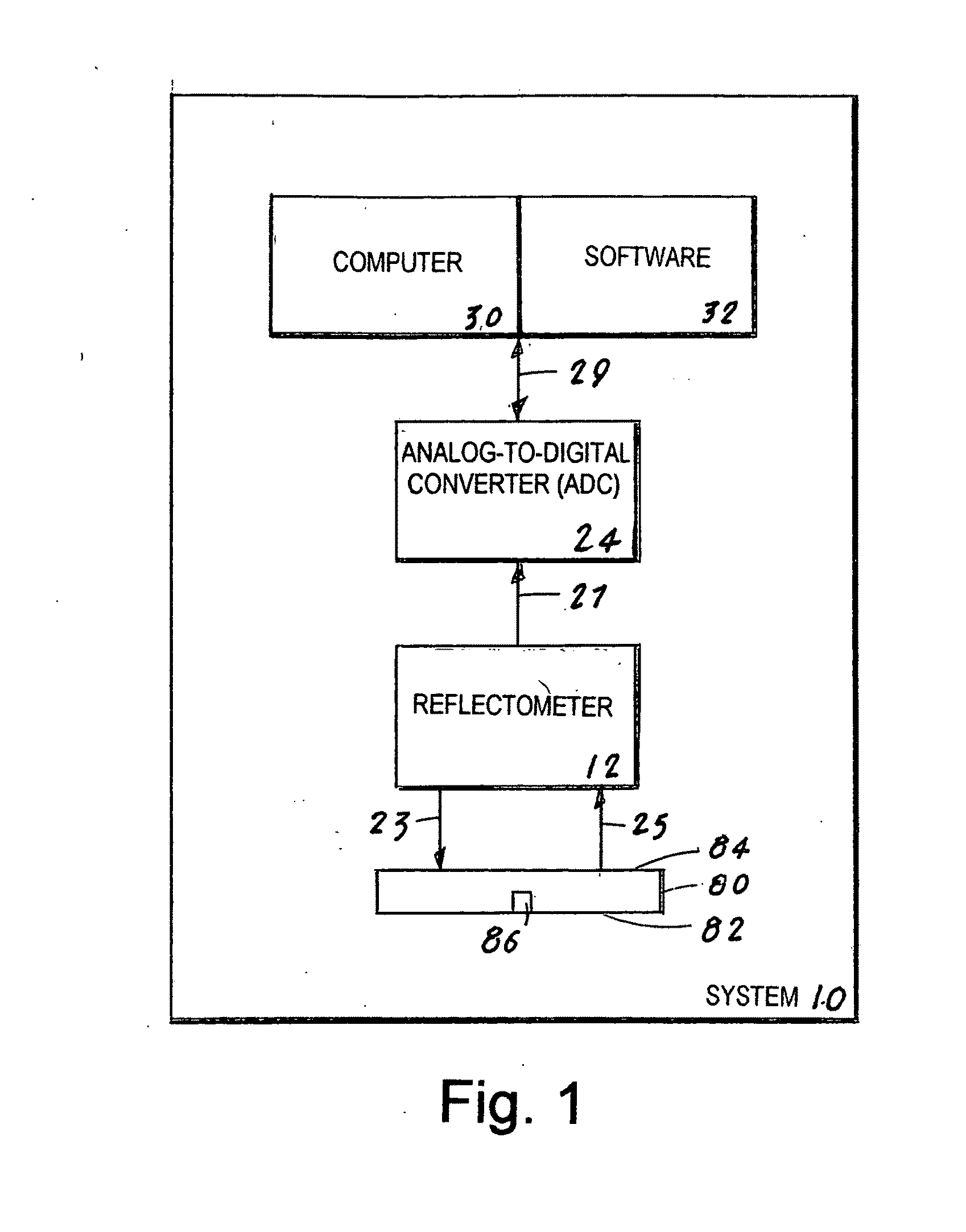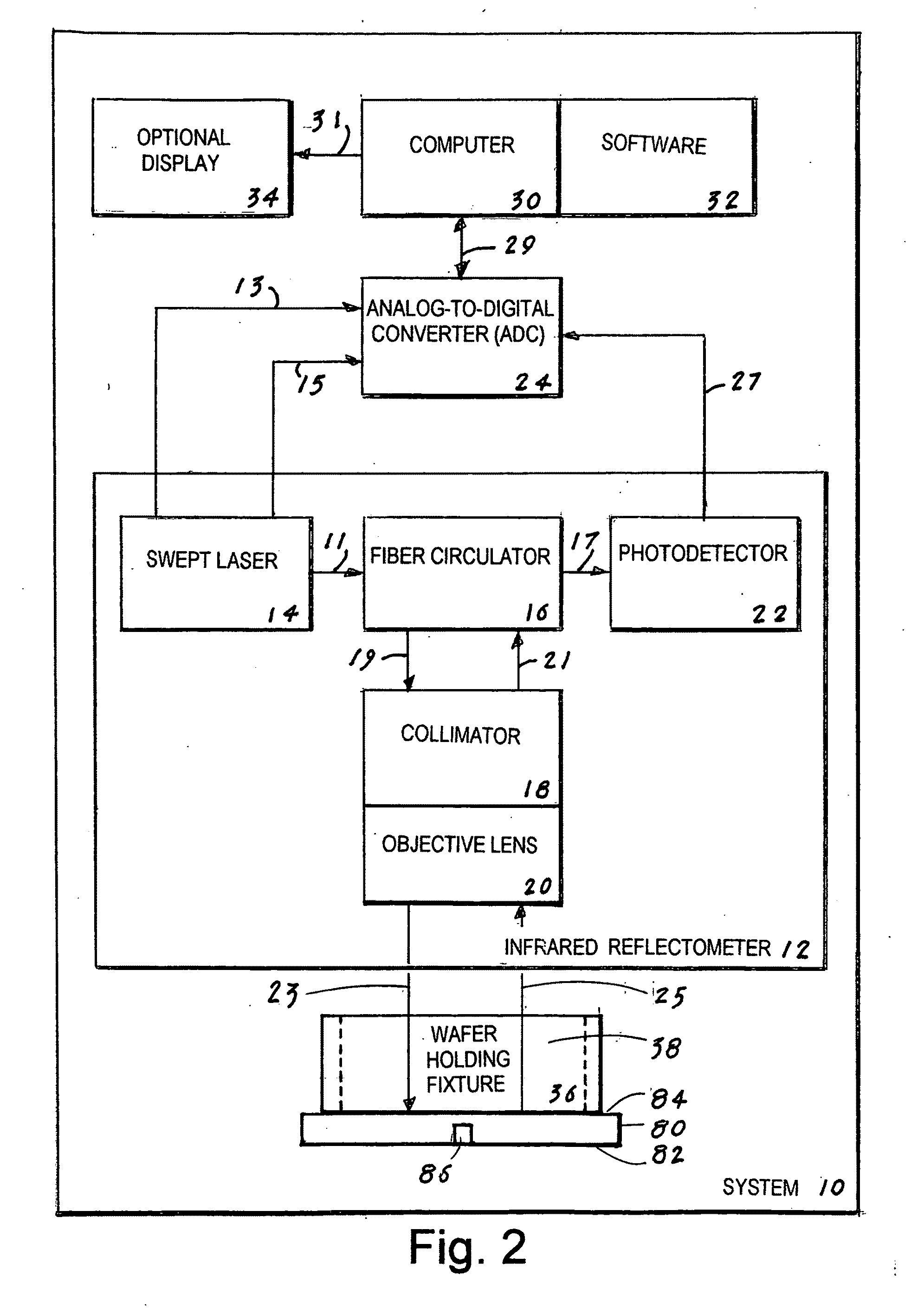System for directly measuring the depth of a high aspect ratio etched feature on a wafer
a technology of etched feature and wafer, which is applied in the direction of optical radiation measurement, instruments, spectrometry/spectrophotometry/monochromators, etc., can solve the problems of large or small reflected light amplitude, and achieve the effect of simple, accurate and reliabl
- Summary
- Abstract
- Description
- Claims
- Application Information
AI Technical Summary
Benefits of technology
Problems solved by technology
Method used
Image
Examples
second embodiment
[0060]The second embodiment which is the preferred embodiment of the system 10, as shown in FIG. 2, is comprised of the following elements: an infrared reflectometer 12, a swept laser 14, a fiber circulator 16, a collimator 18, an objective lens 20, a photodetector 22, an ADC 24, a computer 30, software 32, a display 34 and a wafer holding fixture 36.
[0061]The infrared reflectometer 12 is designed to produce a focused incident light 23, to receive a reflected light 25, and to indicate their ratio. The reflectometer 12 uses a small spot size to illuminate the non-etched surface 84 of the wafer 80. The reflectometer 12 in the second embodiment is comprised of the swept laser 14 which produces a set of wavelengths 11 that are swept in time, a trigger signal 13 and a clock signal 15. The swept wavelengths 11 typically range from 1260 mm to 1360 mm which encompasses a range where the wafer 80 is transparent.
[0062]The fiber circulator 16 has a first input that receives the range of wavele...
third embodiment
[0066]The third embodiment, as shown in FIG. 3, is comprised of the following elements: a broadband incoherent infrared source (BUS) 40, a fiber circulator 16, a collimator 18, an objective lens 20, a spectrometer 42, a computer 30, software 32, a display 34 and a wafer holding fixture 36.
[0067]The broadband incoherent infrared source (BUS) 40 has means for producing an incoherent light 35 that is applied to the first input of the fiber circulator 16. The fiber circulator has a first light output 19 which is directed the light to the collimator 18. The collimator 18 collimates the light which is then focused by the objective lens 20 to produce a focused incident light 23 that is applied to the non-etched surface 84 of the wafer 80. From the wafer 80 is produced a reflected light 25 that is composed of reflections from the non-etched surface 84, the etched surface 82, and any other layers that might comprise the wafer 80. The reflected light 25 is collected by the objective lens 20 a...
PUM
| Property | Measurement | Unit |
|---|---|---|
| wavelengths | aaaaa | aaaaa |
| thickness | aaaaa | aaaaa |
| diameter | aaaaa | aaaaa |
Abstract
Description
Claims
Application Information
 Login to View More
Login to View More - R&D
- Intellectual Property
- Life Sciences
- Materials
- Tech Scout
- Unparalleled Data Quality
- Higher Quality Content
- 60% Fewer Hallucinations
Browse by: Latest US Patents, China's latest patents, Technical Efficacy Thesaurus, Application Domain, Technology Topic, Popular Technical Reports.
© 2025 PatSnap. All rights reserved.Legal|Privacy policy|Modern Slavery Act Transparency Statement|Sitemap|About US| Contact US: help@patsnap.com



